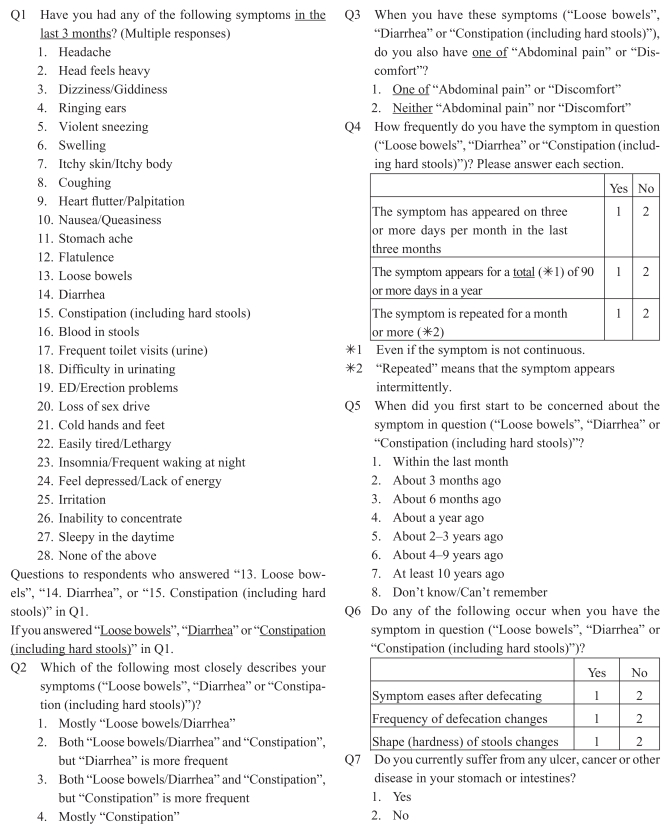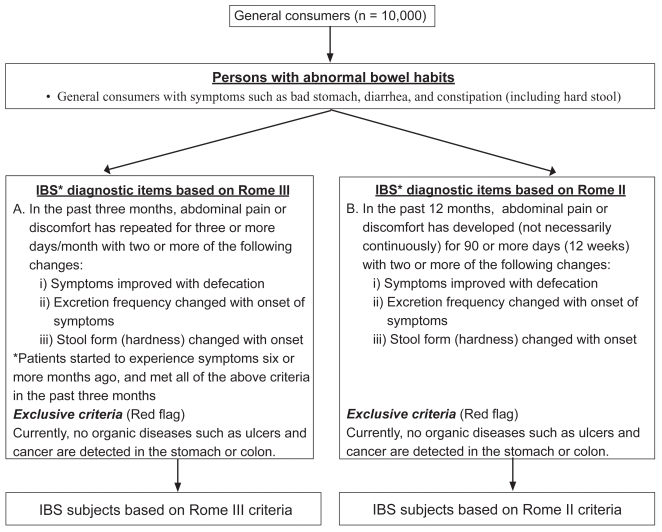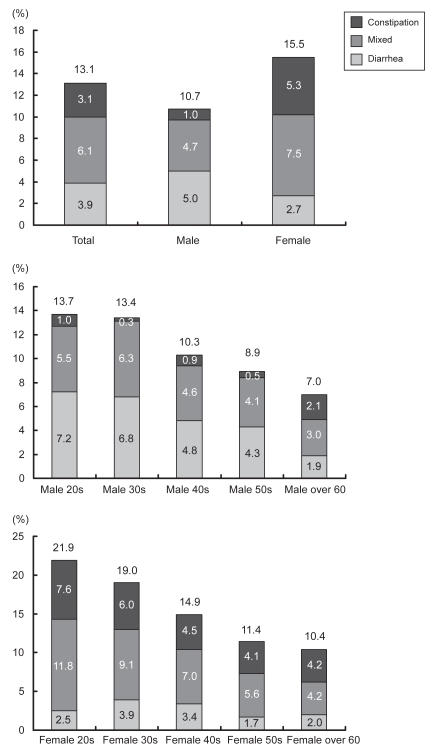Abstract
Objectives
We conducted a large-scale Internet survey of 10,000 subjects across Japan to determine irritable bowel syndrome (IBS) prevalence. (J-ROAD: Japanese research of abdominal symptoms for IBS)
Methods
An equal number of male and female subjects, aged at least 20 years, were surveyed by questionnaire. The prevalence of IBS and its subtypes were determined using Rome III criteria, and the results were analyzed for gender- and age-related differences. IBS prevalence was also determined using Rome II criteria for comparison with Rome III criteria results.
Results
IBS prevalence based on Rome III criteria was 13.1%. IBS with diarrhea (IBS-D) subtype accounted for 29% of these cases, IBS with constipation (IBS-C) subtype 24% of cases, and mixed IBS (IBS-M) subtype 47% of cases. IBS-D was more common in men, while IBS-C predominated in women. IBS was most frequently associated with the 20–29 year age bracket, with prevalence decreasing with age. IBS prevalence based on Rome II criteria was 9.8%.
Conclusion
IBS prevalence based on Rome III criteria was 13.1%. On the other hand, IBS prevalence based on Rome II criteria was 9.8%. Diagnosis based on these updated criteria may uncover more IBS cases than Rome II criteria.
Keywords: irritable bowel syndrome, Rome, epidemiology, prevalence
Introduction
Irritable bowel syndrome (IBS) is one of the functional gastrointestinal disorders (FGIDs) characterized by gastrointestinal symptoms such as abdominal pain or discomfort, and alteration of bowel habits, despite the absence of organic disease (Drossman et al 1994, 1997). IBS is a digestive disorder with high prevalence. Prevalence ranges from 10 to 15% of the general population in major civilized countries, with incidence of 1 to 2% annually (Talley 1999). IBS prevalence varies greatly according to gender. In the West, 2 to 4 times more women exhibit IBS than men (Chang et al 2002). Women have also been shown to be more prone to constipation-predominant IBS than men (Kang 2005). The syndrome generally develops in the late teens to 20s, with onset decreasing with age (Saito et al 2002).
In a small-scale epidemiological study conducted in Japan, IBS prevalence based on Rome II criteria was 14.2% (12.9% male, 15.5% female; N = 417) (Kanazawa et al 2004). The largest-scale epidemiological study was conducted by Kumano and his colleagues (2004) and according to their study report, the IBS prevalence based on Rome II criteria was 6.1% (4.5% male, 7.8% female; N = 4,000). Compared with major western countries, the gender difference was low, while the prevalence was similar.
IBS is conventionally thought of as a neurotic disease. The establishment of the FGIDs concept in recent years has led to a growing need for the development of IBS diagnostic criteria. The Manning criteria (Manning et al 1978) were developed in 1978, followed by the Rome I criteria (Thompson et al 1992) in 1992. The latter was developed as a global diagnostic standard and underwent revision in 1999 due to its complex and difficult application. The resulting Rome II criteria (Thompson et al 1999) were simple and practical, enabling their use in a large number of studies and clinical trials. Rome III criteria (Longstreth et al 2006) were announced in May 2006 and changed the required duration of symptoms from the “last 12 months” to the “past six months.” These criteria also classify the disease among four categories: IBS with diarrhea (IBS-D), IBS with constipation (IBS-C), mixed IBS (IBS-M), unsubtyped IBS (IBS-U).
Here, we set out to conduct the first large-scale IBS epidemiological study in Japan in accordance with Rome III criteria. The objectives of this study were (1) to determine IBS prevalence, subtype classification, gender ratio, and age prevalence, as well as (2) to compare IBS prevalence estimates from the same study population based on Rome II criteria and Rome III criteria.
Materials and methods
Subjects
With the cooperation of Social Survey Research Information Co., Ltd. (Shinjuku, Tokyo), 10,000 general consumers from 47 prefectures in Japan were selected as subjects using the stratified random sampling method. All subjects were at least 20 years of age and were stratified into five age categories (20s, 30s, 40s, 50s, 60 and above). Subjects consisted of 5,000 males and 5,000 females, with each age group consisting of 1,000 subjects. They were surveyed using the Internet beginning from May 23, 2006 until May 30, 2006.
Questionnaires
Descriptions of symptoms in the questionnaire were prepared in accordance with IBS items in Rome III criteria due to the absence of a validated Japanese questionnaire. All questions were simplified to enable the participants to understand the meaning of questions easily (Figure 1).
Figure 1.
Questionnaire (n = 10,000).
Diagnostic criteria
Subjects were categorized as having IBS based on Rome III and Rome II criteria (Figure 2). To meet the IBS classification according to Rome II or III criteria, subjects must have had bowel habits that were consistent with each respective criterion, without meeting any exclusion criteria.
Figure 2.
Diagnostic items of irritable bowel syndrome.
Abbreviations: IBS, irritable bowel syndrome.
Rome III subtype classification was performed as follows. Subjects affected mainly by “loose bowels/diarrhea” were classified into IBS-D. Those that were mainly affected by “constipation” were classified into IBS-C, and those with both were considered to be IBS-M.
Results
The total IBS prevalence based on Rome III criteria was 13.1% (1,309/10,000) (Table 1). The prevalence among women was 15.5% and that among men was 10.7%. Among the subjects who met Rome III criteria, 29% were categorized as having IBS-D, with this subtype being more common among males (male 47%, female 17%; Figure 3). Conversely, although 24% were classified as having IBS-C, the majority was female (male 9%, female 34%; Figure 3). Forty-seven percent of subjects were classified as having IBS-M (male 44%, female 49%). The prevalence of the IBS-D was highest among males in their 20s (7.2%), and that of IBS-C was highest among females in their 20s (7.6%) (Figure 3).
Table 1.
Number of subjects with IBS by IBS diagnostic criteria (%)
| Diagnostic criteria | (n = 10,000) | 95% confidence interval |
|---|---|---|
| According to Rome III criteria | 13.1% (1,309 persons) | 12.4%–13.8% |
| According to Rome II criteria | 9.8% (976 persons) | 9.2%–10.3% |
| According to Rome II criteria and Rome III criteria | 7.1% (706 persons) | 6.6%–7.6% |
| According to Rome III criteria only | 6.0% (603 persons) | 5.6%–6.5% |
| According to Rome II criteria only | 2.7% (270 persons) | 2.4%–3.0% |
| Neither Rome II criteria nor Rome III criteria | 84.2% (8,421 persons) | 83.5%–84.9% |
Abbreviations: IBS, irritable bowel syndrome.
Figure 3.
Prevalence of IBS by subtype, gender, and age group according to Rome III criteria.
The IBS prevalence based on Rome II criteria was 9.8%. Thus, revision to Rome III criteria increased this percentage by about 1.3 times. Incidentally, 7.1% of the subjects satisfied both Rome II criteria and Rome III criteria, 6.0% satisfied Rome III criteria only, 2.7% satisfied Rome II criteria only, and 84.2% satisfied neither of the two (Table 1).
Discussion
We conducted a large-scale, Internet-based epidemiological study investigating 10,000 general consumers across Japan according to Rome III criteria. As subjects were those registered on the Internet, one demerit was that doctors and other medical professionals were unable to directly assess them. Furthermore, generally speaking, some of the problems entailed by Internet surveys, compared to conventional interview surveys, are such as when respondents pretend to be someone they are not and when the selection of respondents is biased. For this study, we took some measures to prevent such problems; we asked the respondents their personal information (to prevent them from pretending to be someone they are not) while adopting a stratified random sampling method by gender and age (to avoid any biased selection of respondents). Consequently, as many as 10,000 consumers nationwide were enrolled into the study, with each age group equally consisting of 1,000 subjects, and IBS prevalence was considered accurate. Actually, IBS prevalence was nearly consistent between the present study and IBS epidemiological studies conducted in Japan. As of 2004, two years before this questionnaire was performed, Internet use by those aged 65 years or older was less than 50% (Ministry of Internal Affairs and Communications 2004), while use by those in their 20s to 40s exceeded 80%. Thus, Internet surveys are an appropriate means for collecting facts on IBS, a syndrome most frequently observed in younger generations.
The results of this study revealed that the total IBS prevalence in Japan is approximately 13.1%. Also, IBS prevalence based on Rome II criteria is 9.8%. Meanwhile, only 2.7% of the subjects satisfy Rome II criteria and this suggests that the prevalence rate was increased by the symptom duration being shortened from 12 months to 6 months. Based on demographic data (as of November 1, 2005) from the Bureau of Statistics, Japanese Ministry of Internal Affairs and Communications (2006), about 12 million consumers are estimated to have IBS across the nation. Given that there are an estimated 16.2 million Japanese with actual and possible diabetes (Ministry of Health, Labour and Welfare 2003), the illness is called a national affliction of the Japanese. The results of our study confirmed once again that the prevalence of IBS is very high as compared to diabetic data in Japan.
The prevalence of IBS among 5,000 males and 5,000 females was 10.7% and 15.5%, respectively. Analysis based on the stratification by age group revealed that, irrespective of gender, IBS was observed more frequently in younger populations. By subtype of the disease, IBS-D was more common among males and IBS-C among females. The former type of IBS is said to result in poorer QOL than the latter type (Kevin et al 2006). Given that there are more male patients with IBS-D in Japan, the impact on society is higher than in other countries.
In the past, as IBS excluded transient bowel habit problems caused by acute diseases such as gastroenteritis, it had to be set with a prolonged symptom duration (Thompson et al 1999). In this study, Rome III criteria were used for diagnosis. On the new diagnostic criteria, the symptom duration of IBS has been reduced to 6 months. IBS prevalence according to Rome III criteria increased about 1.3 times compared with Rome II criteria. The results suggest that diagnosis based on Rome III in the future may identify more IBS patients, who would not be given such a diagnosis with the older diagnostic criteria.
In conclusion, IBS prevalence based on Rome III criteria was 13.1%. On the other hand, IBS prevalence based on Rome II criteria was 9.8%. These results indicate an increase in the number of IBS patients due to the symptom duration being shortened to 6 months.
References
- Chang L, Heitkemper MM. Gender differences in irritable syndrome. Gastroenterology. 2002;123:1686–701. doi: 10.1053/gast.2002.36603. [DOI] [PubMed] [Google Scholar]
- Drossman DA, Richter JE, Talley NJ, et al. Functional gastrointestinal disorders. Boston: Little, Brown and Co; 1994. pp. 1–174. [Google Scholar]
- Drossman DA, Whitehead WE, Camilleri M, et al. Irritable bowel Syndrome: A technical review for practice guideline development. Gastroenterology. 1997;112:2120–37. doi: 10.1053/gast.1997.v112.agast972120. [DOI] [PubMed] [Google Scholar]
- Gralnek IM, Hays RD, Kilbourne A, et al. The impact of irritable bowel syndrome on health-related quality of life. Gastroenterology. 2000;119:654–60. doi: 10.1053/gast.2000.16484. [DOI] [PubMed] [Google Scholar]
- Kanazawa M, Endo Y, Whitehead WE, et al. Patients and nonconsulters with irritable bowel syndrome reporting a parental history of bowel problem have more impaired psychological distress. Dig Dis Sci. 2004;49:1046–53. doi: 10.1023/b:ddas.0000034570.52305.10. [DOI] [PubMed] [Google Scholar]
- Kang JY. Systematic review: the influence of geography and ethnicity in irritable bowel syndrome. Aliment Pharmacol Ther. 2005;21:663–76. doi: 10.1111/j.1365-2036.2005.02396.x. [DOI] [PubMed] [Google Scholar]
- Kevin C, Peggy H, Monica E, et al. Abdominal pain impacts quality of life in women with irritable bowel syndrome. Am J Gastroenterol. 2006;101:124–32. doi: 10.1111/j.1572-0241.2006.00404.x. [DOI] [PubMed] [Google Scholar]
- Kumano H, Kaiya H, Yoshiuchi K, et al. Comorbidity of irritable bowel syndrome, panic disorder, and agoraphobia in Japanese representative sample. Am J Gastroenterol. 2004;99:370–6. doi: 10.1111/j.1572-0241.2004.04048.x. [DOI] [PubMed] [Google Scholar]
- Longstreth GF, Thompson WG, Chey WD, et al. Functional bowel disorders. Gastroenterology. 2006;130:1480–91. doi: 10.1053/j.gastro.2005.11.061. [DOI] [PubMed] [Google Scholar]
- Manning AP, Thompson WG, Heaton KW, et al. Towards positive diagnosis of the irritable bowel syndrome. BMJ. 1978;ii:653–4. doi: 10.1136/bmj.2.6138.653. [DOI] [PMC free article] [PubMed] [Google Scholar]
- Ministry of Health, Labour and Welfare. Diabetes Survey FY2002 [online; in Japanese] 2003. [Accessed on December 10, 2007]. URL: http://www.mhlw.go.jp/shingi/2004/03/s0318-15.html.
- Ministry of Internal Affairs and Communications. 2004. Communications Use Survey.
- Ministry of Internal Affairs and Communications. Current Population Estimates as of November 1, 2005. Bureau of Statistics [online; in Japanese] 2006. [Accessed December 10, 2006]. URL: http://www.stat.go.jp/data/jinsui/index.htm.
- Saito YA, Schoenfeld P, Locke GR. The epidemiology of irritable bowel syndrome in North America: a systematic review. Am J Gastroenterol. 2002;97:1910–15. doi: 10.1111/j.1572-0241.2002.05913.x. [DOI] [PubMed] [Google Scholar]
- Talley NJ. Irritable bowel syndrome: definition, diagnosis and epidemiology. Baillieres Best Pract Res Clin Gastroenterol. 1999;13:371–84. doi: 10.1053/bega.1999.0033. [DOI] [PubMed] [Google Scholar]
- Thompson WG, Creed F, Drossman DA, et al. Functional bowel disorders and chronic functional abdominal pain. Gastroenterol Int. 1992;5:75–91. [Google Scholar]
- Thompson WG, Longstreth GF, Drossman DA, et al. Functional bowel disorders and functional abdominal pain. Gut. 1999;45(Suppl II):II43–7. doi: 10.1136/gut.45.2008.ii43. [DOI] [PMC free article] [PubMed] [Google Scholar]





